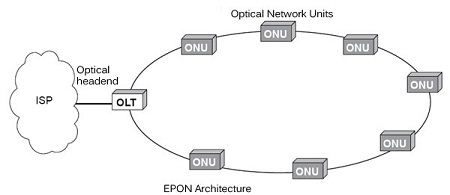When the frames transmitted on the PON are Ethernet, EPON talking. The features of this network are identical to those of the other PON: distribution throughout the network, where only the station specified in the Ethernet frame can retrieve the information conveyed. The standardization of EPON technology is performed by the IEEE 802.3ah group. This group has several objectives, including that of introducing Ethernet in the local loop under the name of EFM (Ethernet in the First Mile). The objective was to replace the ATM technology, very expensive to implement on a multipoint technology, the Ethernet technology.
In the EPON technology, the frame from the OLT (Optical Line Termination) is broadcast to all the ONU (optical network unit) (64 maximum). The network head is connected to an ISP to allow the transmission of IP packets encapsulated in Ethernet frames. Figure shows an architecture of EPON loop.

The UN recognizes its address gets the Ethernet frame, the size of which can reach a length of 1518 bytes. In the uplink direction, the Ethernet frames are transmitted in a TDM technology (Time Division Multiplexing) solution used in conventional Ethernet, CSMA/CD, being unsuited to EPON speeds. Multiplexing in the downward direction is exerted on the fixed length slots so that the Ethernet frames are to be divided into segments of constant length, with the exception of the last part, which can be less than the length of the slot.
Synchronization is essential so that there is no collision between the slots. This synchronization occurs every 2 ms, corresponding to the length of the physical frame that contains all the slots of the UN.
The physical level uses two or three wavelengths. With two wavelengths, it is possible to use the uplink and downlink channels. The network length in this case reached twenty kilometers with 32 stars passive. With three wavelengths, it is possible to add a downlink channel for broadcast television channels.
The quality of service can be obtained by introducing a priority using dedicated to Ethernet, a zone indicating the priority of the frame.
 Dinesh Thakur holds an B.C.A, MCDBA, MCSD certifications. Dinesh authors the hugely popular
Dinesh Thakur holds an B.C.A, MCDBA, MCSD certifications. Dinesh authors the hugely popular